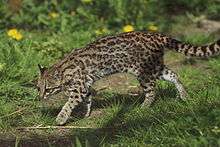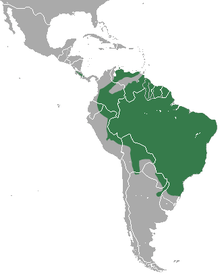Oncilla
| Oncilla[1] | |
|---|---|
 | |
| Scientific classification | |
| Kingdom: | Animalia |
| Phylum: | Chordata |
| Class: | Mammalia |
| Order: | Carnivora |
| Family: | Felidae |
| Genus: | Leopardus |
| Species: | L. tigrinus |
| Binomial name | |
| Leopardus tigrinus (Schreber, 1775) | |
 | |
| Oncilla range (needs updating) | |
| Synonyms | |
|
Oncifelis tigrinus | |
The oncilla (Leopardus tigrinus), also known as the little spotted cat, tigrina, tigrillo, or tiger cat, is a small spotted cat native to montane and tropical rainforests of Central and South America. It is active during the night and in twilight, but has also been recorded during the day.[2]
The oncilla is a close relative of the ocelot and the margay, and has a rich ochre coat, spotted with black rosettes.
Characteristics
The oncilla resembles the margay and the ocelot.[3] But it is smaller, with a slender build and narrower muzzle. It grows to 38 to 59 centimetres (15 to 23 in) long, plus a 20 to 42 centimetres (7.9 to 16.5 in) tail.[4] While this is somewhat longer than the average domestic cat, Leopardus tigrinus is generally lighter, weighing 1.5 to 3 kilograms (3.3 to 6.6 lb).[5]
The fur is thick and soft, ranging from light brown to dark ochre, with numerous dark rosettes across the back and flanks. The underside is pale with dark spots and the tail is ringed. The backs of the ears are black with bold ocelli. The rosettes are black or brown, open in the center, and irregularly shaped. The legs have medium-sized spots tapering to smaller spots near the paws. This coloration helps the oncilla blend in with the mottled sunlight of the tropical forest understory. The oncilla's jaw is shortened, with fewer teeth, but with well-developed carnassials and canines.[3]
Some melanistic oncillas have been reported from the more heavily forested parts of its range.[4]
Behavior
The oncilla is a primarily terrestrial animal, but is also an adept climber. Like all cats, the oncilla is an obligate carnivore, requiring meat for survival. This cat eats small mammals, lizards, birds, eggs, invertebrates, and the occasional tree frog. Occasionally, the cat will eat grasses. The oncilla stalks its prey from a distance, and once in range, it pounces to catch and kill the prey.[6]
They are generally nocturnal, but in areas such as Caatinga, where their main food source consists of diurnal lizards, they are more likely to be active during the day. Young oncillas have been observed to purr, while adults are known to make short, gurgling calls when close to one another.[4]
Distribution and habitat
Oncillas are typically distributed from Costa Rica through Northern Argentina, and show a strong preference for montane forest. They are usually found in elevations higher than those of the margay or ocelot. They have been found in habitats as high as 4500m in Colombia, in the Andean highlands in Ecuador and Peru, and in the subtropical forest highlands in Brazil.[7] They have also been identified in cerrado and scrubland environments.[4]
They have been recorded in northern Panama, but the remainder of the country appears to be a gap in the range of the species.[8]
In 2013, it was proposed to assign the population in southern Brazil to a new species, L. guttulus, after it was found not to be interbreeding with the L. tigrinus population in northeast Brazil.[9]
Reproduction
Estrus lasts from 3 to 9 days, with older cats having shorter cycles.[8] Oncillas produce 1 to 3 kittens (usually only one), after a gestation of 74 to 76 days.[8] The kittens' eyes open after eight to seventeen days, an unusually long period for a cat of this size. Unlike other cats, in which the incisor teeth tend to appear first, the teeth of an oncilla kitten erupt more or less simultaneously, at around 21 days of age.[10] The kittens do not begin to take solid food until they are 38 to 56 days old (much older than in the domestic cat), but are fully weaned at three months.[4]
Oncillas reach sexual maturity at around two to two and a half years of age. They have a life span of about 11 years in the wild, but there are records of these cats reaching an age of 17 years.[8]
Subspecies
The following are the traditionally recognized subspecies:[1]
- Leopardus tigrinus tigrinus, eastern Venezuela, Guyana, northeastern Brazil
- Leopardus tigrinus guttulus, Atlantic forest central and southern Brazil, Uruguay, Paraguay, northern Argentina (later recognised as a separate species)
- Leopardus tigrinus oncilla, Central America[11]
- Leopardus tigrinus pardinoides, western Venezuela, Colombia, Ecuador, Peru
Although the Central American oncilla is listed as a separate subspecies, based on analysis of mitochondrial DNA, Johnson et al. (1999) found strongly supported differences between L.t. oncilla in Costa Rica and L.t. guttulus in southern Brazil, comparable to differences between different neotropical species. Researchers have argued that there should be a splitting of the oncilla into two species, as there is a pronounced difference in appearance between the oncillas in Costa Rica and those in central and southern Brazil. The level of divergence between oncillas from Costa Rica and from central and southern Brazil suggests that the two populations have been isolated, perhaps by the Amazon River, for approximately 3.7 million years.[12] Further samples of L.t. oncilla are needed from northern South America to determine whether this taxon ranges outside Central America, and whether it should be considered a distinct species rather than a subspecies.[11]
In 2013, genetic research revealed that the former subspecies L. t. guttulus is a separate cryptic species that does not interbreed with the other subspecies, and proposes a classification into two species L. guttulus and L. tigrinus.[9]
A zone of hybridization between the oncilla and the colocolo has been found through genetic analyses of specimens from central Brazil.[13]
Conservation
_fur_skins.jpg)
The International Union for the Conservation of Nature (IUCN) has classified the oncilla as vulnerable. The chief threats to these felines are deforestation and poaching. Oncillas are killed for their pelts, which are highly prized and often sold or made into clothing.[2] Reports in 1972 and 1982 in South America showed that the oncilla is one of the four most heavily hunted of all the small cats.[14]
Another factor contributing to oncilla mortality is human expansion, settling what was once open terrain for wild cats. Coffee plantations are most often established in cloud forest habitats, causing the reduction of preferred habitats.[15]
CITES places the oncilla on Appendix I, prohibiting all international commerce in oncillas or products made from them.[2] Hunting is still allowed in Ecuador, Guyana, Nicaragua, and Peru.[14]
Hybridization of the oncilla with the Geoffroy's cat (Leopardus geoffroyi) has been found in the southernmost part of its range; hybridization with the pampas cat (Leopardus pajeros) has also been found in central Brazil. Such hybridization may be a natural process, and the extent of this as a threat to the oncilla is unknown.[16]
Cat specialist groups are involved in studies and conservation of cats in all continents.[14] In situ management programs are increasingly being emphasized.[15]
There is a breeding facility in Brazil for several small native felines, where their natural conditions and native food encourage reproduction similar to that in the wild.[14] There are a few oncillas in captivity in North America, and a few in zoos in Europe and South America. In captivity, the oncilla tends to have high infant mortality rate.[15]
References
- 1 2 Wozencraft, W.C. (2005). "Order Carnivora". In Wilson, D.E.; Reeder, D.M. Mammal Species of the World: A Taxonomic and Geographic Reference (3rd ed.). Johns Hopkins University Press. p. 539. ISBN 978-0-8018-8221-0. OCLC 62265494.
- 1 2 3 4 de Oliveira, T., Eizirik, E., Schipper, J., Valderrama, C., Leite-Pitman, R. and Payan, E. (2008). "Leopardus tigrinus". IUCN Red List of Threatened Species. Version 2013.2. International Union for Conservation of Nature.
- 1 2 Leyhausen, P. (1963). "Über südamerikanische Pardelkatzen". Zeitschrift für Tierpsychologie. 20 (5): 627–640. doi:10.1111/j.1439-0310.1963.tb01179.x.
- 1 2 3 4 5 Sunquist, M.; Sunquist, F. (2002). Wild Cats of the World. Chicago: University of Chicago Press. pp. 130–134. ISBN 0-226-77999-8.
- ↑ University of Michigan Museum of Zoology
- ↑ Leyhausen, P. & Tonkin, B. A. (1979). "Cat behaviour. The predatory and social behaviour of domestic and wild cats". New York: Garland STPM Press.
- ↑ Mondolfi, E., Hoogesteijn, R. (1986). "Notes on the biology and status of the small wild cats in Venezuela". Miller, S. D., Everett, D. D. (eds.), Cats of the World: Biology, Conservation and Management. Washington, DC: National Wildlife Federation. pp. 125–146.
- 1 2 3 4 Nowell, K., Jackson, P. (1996). The Wild Cats: A Status Survey and Conservation Action Plan. Gland: IUCN.
- 1 2 Trigo, Tatiane C.; Schneider, Alexsandra; de Oliveira, Tadeu G.; Lehugeur, Livia M.; Silveira, Leandro; Freitas, Thales R.O.; Eizirik, Eduardo (November 2013). "Molecular Data Reveal Complex Hybridization and a Cryptic Species of Neotropical Wild Cat". Current Biology. doi:10.1016/j.cub.2013.10.046. Cite uses deprecated parameter
|coauthors=(help) - ↑ Quillen, P. (1981). "Hand-rearing the little spotted cat or oncilla". International Zoo Yearbook. 21: 240–242. doi:10.1111/j.1748-1090.1981.tb01994.x.
- 1 2 de Oliveira, T., Schipper, J. and Gonzalez-Maya, J. F. (2008). "Leopardus tigrinus ssp. oncilla". IUCN Red List of Threatened Species. Version 2013.2. International Union for Conservation of Nature.
- ↑ http://felids.wordpress.com/2010/11/03/featured-feline-oncilla/ International Society for Endangered Cats
- ↑ Pereira, J., Lucherini, M., de Oliveira, T., Eizirik, E., Acosta, G. and Leite-Pitman, R. (2008). "Leopardus colocolo". IUCN Red List of Threatened Species. Version 2013.2. International Union for Conservation of Nature.
- 1 2 3 4 Foreman, G. E. (ed.) (1988). "Felid bibliography 1781-1988". Columbus, Ohio: Felid Research and Conservation Interest Group: 34–72.
- 1 2 3 Fuller, K.S., Swift, B. (1985). Latin American Wildlife Trade Laws. Washington, DC: Traffic (USA).
- ↑ Eizirik, E., Trigo, T. C. and Haag, T. (2007). Conservation genetics and molecular ecology of Neotropical felids. In: J. Hughes and R. Mercer (eds.), Felid Biology and Conservation Conference 17–19 September: Abstracts. Pp. 40–41. WildCRU, Oxford, UK.
External links
| Wikispecies has information related to: Leopardus tigrinus |
| Wikimedia Commons has media related to: |
-
 "Tiger-cat". Encyclopædia Britannica (11th ed.). 1911.
"Tiger-cat". Encyclopædia Britannica (11th ed.). 1911. - Species portrait Leopardus tigrinus; IUCN/SSC Cat Specialist Group
